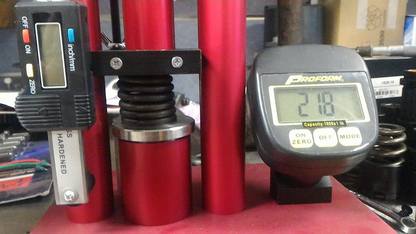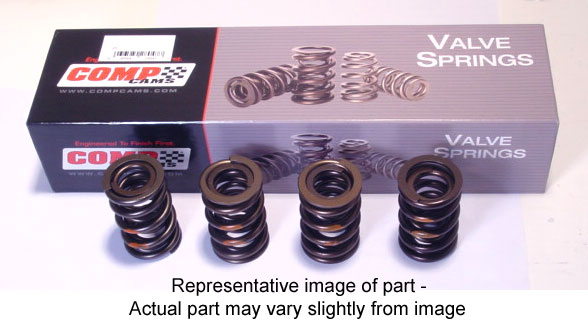|
Valve springs concerning a Magnum are very limited. Currently the best drop in available is the Mopar Performance p4976062 spring and p4452032 retainer (2.2 Chrysler retainer lol). Magnums are limited due to the shorter 4.91" length valve. That ends up with installed heights around 1.650" to 1.640". Subtract 0.600 lift from that and you are already at 1.040" The valve stem seal and seat to retainer clearance is usually 0.465 to 0.470 max. So cutting down the seat and stem guide boss are required on Magnum heads. By far the most used spring combo is the Mopar Performance spring that was specifically designed for the smaller 1.420" valve spring seat machined into the heads. If you are not looking to open the heads up to 1.500" and cut the seat and guides down, then this drop in is a true bolt on for your aftermarket cams. You can simply order those from Summit or Jegs at the lowest price they both offer. Now I am designing new roller cam profiles that will work with your stock springs. Stock springs when not worn out, are lighter in mass than the heavy springs offered by Mopar. Do not get me wrong, I am not saying they are better. I am saying, if your cam profile is small enough to work with that spring, then there is no need to shift past 5000 rpm. Number one as you can see, it is only 220lbs at 0.485" lift. Number two, your long runner intake manifold is done at 4800 rpm. Now if you are running a Mopar single plane intake manifold, then you need spring pressures that are over 300 to pull 5500+. The kits from Hughes, Performance Injection Equipment and Mopar will get you those pressures. If you think for a moment that you can rev 6500 with any of those springs and make power, forget it. Those springs will not make any power past 6000 rpm, especially with the steel retainer being 27 grams. Lighten to a titanium retainer and you will gain 100-200 rpm. The only way to make true power past that is to machine the heads for double springs or a beehive spring. The later being the best choice. A standard steel beehive retainer is 10 grams, a Titanium version is 6 grams. Plus the harmonics of a Beehive ovate spring outperform any standard in minimizing oscillation. Another option is to run 0.100" longer valves, but you will need to change pushrod lengths. Rocker geometry will still be safe if you stay below that 0.100 length. If you stay with your stock springs due to wanting low end torque for your Moab or Bear Trail machine, then for a safe setup when choosing a camshaft, keep the lift around 0.450". That gives you 0.060" or more safe bind clearance as the stock spring will bind at 0.520". That is why 1.7 roller rockers work well on stock cams and springs.
9 Comments
Here is some rear mount turbo info for those who asked. First, you can run a muffler behind the turbo if you choose, of not if you want the cool cruising sound. Machs Nix...makes no difference as long as you stay the same diameter of the turbo outlet. Second, intercoolers are usually not needed due to the length of outlet piping headed forward on the truck to the throttle body. Since the turbo sits lower than the engine, being oil fed, it has to return that oil back to the engine. I used to use TurboWerks, now it is all CX Racing parts. Make sure the line is at least #8 returning to the engine. Some folks tap the oil pan, some return to the valve cover, some are more detailed. Keep in mind, you can send too much oil to the turbo and modifying nitrous jets to use in the inlet of the turbo works well to keep from blowing the turbo seal out. Most turbos come with restriction inlets now anyways. I weld my piping flanges in place and simply run a pre filter on the K&N filters to the inlet. If it is an off road project, I work hard to mount the turbo upfront, not in the rear. Depending upon boost levels and whether the engine is stock, determines the boost level. Most mags respond well with 6-8psi. Intercooling never hurts, as the cooler the intake temp, the more spark advance you can run. Timing with no intercooler needs to stay around 16-18 degrees at 11.8afr. With an intercooler you can run 20-22 with 11.8 afr target. Egt should be safe at 1200 or much less. You will need a 2 bar MAP sensor, 60lb injectors, and a SCT with a 2bar calibration in it. Keep the wastegate close to the turbo, keep the blowoff valve on the exit side of the intercooler or close to the throttle body airhat. 60mm will come on around 2800, a big 76 will come on much later. I always, run Cometic head gaskets with ARP head studs, and seal the plenum of the intake. Better valvesprings should be considered as it will try to lift them under boost. Here are a few shots... |
Marty FletcherHands on engine builder and tuner for Dodge since 1993. Archives
July 2023
Categories |

